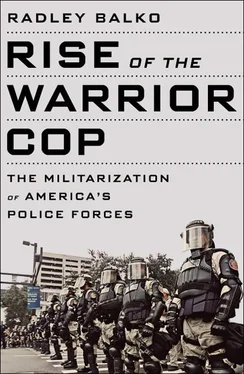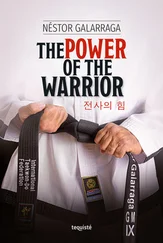NOT ALL POLICE OFFICIALS SHARED DARYL GATES’S APPROACH to the use of force. Norm Stamper still remembers the case that changed his mind about police militarization. Stamper joined the San Diego Police Department in 1966 as a beat cop. By March 12, 1987, he had worked his way through the ranks to the position of field operations chief. That was the evening Tommie DuBose died. 18
“We were serving a series of high-risk warrants all over the city that day,” Stamper says. “They were going on all day. My guys who were serving the warrants weren’t a SWAT team, but undercover field operations cops who had been working with narcotics. At around six or seven in the evening, they hit a house in east San Diego.”
It was the home of DuBose, a fifty-six-year-old civil servant who had worked for over twenty years for the US Navy. Their warrant was for Tommie’s son, Charles, who was wanted for drug distribution. Tommie DuBose knew his son had a drug problem. Consequently, he was an outspoken opponent of drug use and abuse. “But he had nothing to do with that himself,” Stamper says. “Perhaps somewhat naively, I don’t think he had any suspicion that his son was doing anything more than using.”
According to subsequent reports, the police knocked and announced themselves, then forced entry when an officer claimed to have seen DuBose run to the back of the house. Once they made their way inside, DuBose threw a glass of wine into the face of Officer Andy Rios. Police say the two men then engaged in a struggle over Rios’s gun. Officer Carlos Garcia then opened fire, shooting DuBose five times, four times in the back. DuBose died in his home.
“I wasn’t personally involved, but these were my guys,” Stamper says. “They called me in. I showed up shortly afterward, and I saw this man lying dead in his own living room. He was just watching TV. He had no criminal record. All he knew was that some armed men were breaking into his house.”
The incident hit Stamper hard. “Just overwhelming heartsickness. I mean, this man wasn’t armed, he was not named in the warrant. He spoke out against drug use because he saw what it had done to his kid. And you know, God knows how many other times we scared the bejesus out of innocent people. You hit the wrong house. Or you hit the right house, but there are wives, girlfriends, kids inside completely unaware of what’s going on. They could be completely ignorant of any drug-related criminal activity, but a girlfriend’s home or apartment might have a stash that their male partner has secreted away. And so they’d get raided too. When one of these raids would just scare the hell out of women, children, family pets, it just made me wonder what in the world we were doing, and why the hell we were doing it.”
Tommie DuBose’s wife, brother-in-law, and twenty-five-year-old son Brett were all in the house at the time of the raid. None of them heard either the knock or the announcement. One neighbor who saw the entire raid estimated that only about fifteen seconds expired from the time the police pulled up until he heard gunshots. Others said that they never heard any announcement. Brett DuBose said that he first saw the police pull up from the window in another room, but that they were in the house before he had time to say anything.
The San Diego County District Attorney’s Office eventually cleared the raiding officers of any wrongdoing, but the report did question their tactics. It found that the yellow jackets they wore during raids didn’t make it clear enough to citizens that they were police. And in the DuBose raid specifically, the DA found that the officers didn’t properly announce themselves and didn’t wait long enough after the announcement before entering.
The San Diego Police Department eventually acknowledged that DuBose was an innocent victim. Assistant Chief Bob Burgreen even acknowledged that the police had made some mistakes. “The officers did not allow enough time or enough notice,” he told the Los Angeles Times . “They did not give the DuBose family enough time to answer the door adequately before they went into the house. The entry that quickly was not justified.” But Burgreen added that because their mistakes were made in good faith, none of the officers would be disciplined. And the officers involved would continue to serve high-risk drug warrants.
The problem was that this wouldn’t be the only mistake. On March 2, 1988, San Diego police conducted a 2:20 AM raid on the home of John Taylor, his brother George, and George’s wife. Forty-four-year-old George Taylor was thrown to the floor with a gun to his head. An officer then stepped on his neck to keep him in place while they searched the house. He’d had spinal surgery a year earlier. The police apologized when they realized they had intended to raid the house next door. But a week later the Taylors were again awoken by San Diego police. The cops were again raiding the house next door. This time one officer mistakenly smashed out the windows to the Taylors’ home, then pushed the barrel of his gun inside. 19
Eighteen months after the DuBose raid, San Diego police stormed the home of Adelita Pina and her three daughters. They expected to find a major drug operation, including “kilos” of marijuana, firearms, and ammunition. They found nothing. Lt. Dan Berglund, head of the city’s narcotics team, refused to admit that they had made a mistake, and retreated to the now-familiar excuse that though Pina may have been innocent, someone else must have been selling drugs from her house. Of course, that excuse completely missed the point—and showed how the drug war could blind police to the rights and well-being of the people they were supposed to be serving. Berglund’s defense of the raid was that his officers had correctly raided the house where undercover cops had bought drugs from a man named “Pete.” That Pete didn’t actually live at the house, or that three young girls, their aunt, and their uncle were subjected to a terrifying raid that turned up nothing, was all beside the point. Technically, Berglund’s cops were probably right. That was all that mattered. Therefore the raid was justified. 20
Five months later, another mistaken raid. Police said that they knocked on Ken Fortner’s door, then decided to break it down when they heard noises inside indicating that someone was destroying evidence. But as Commander Larry Gore told the Los Angeles Times , during the pre-raid briefing someone “inadvertently wrote down the wrong number.” Fortner was thrown face-first into a flight of stairs. His friend Kelly McAloon was tossed onto a concrete patio and suffered injuries to his ribs that required a trip to the emergency room for X-rays. Like Berglund, Gore’s justification once again glossed over the harm done. “They went to this location with the best of intentions,” he said. “They were armed with all the correct information, and they had a legitimate reason to do what they did. They just had the wrong address.” 21
But unlike other parts of the country, things did improve in San Diego. In response to the mistaken raids and a number of questionable police shootings, Stamper spearheaded a series of reforms to move the department to a more community-oriented style of policing. By the early 1990s, San Diego police officials and city leaders were in regular contact with civil rights and minority leaders. The city set up a hotline to report police abuse, and persuaded a local TV station to host a telethon in which viewers could call in to have on-air conversations with city leaders.
In 1993 the Los Angeles Times credited those efforts with saving the city from the riots that hit Los Angeles after the verdict in the Rodney King beating case in 1992. 22City and police officials in San Diego were quick to denounce the acquittal of the LAPD officers who beat Rodney King, but more importantly, they had direct lines to the city’s minority communities when the verdict was announced. They could build a strategy around empathy, not antagonism. Consequently, city officials knew that angry people would want to vent. So rather than suppress demonstrations, they allowed them—and in fact encouraged them.
Читать дальше













